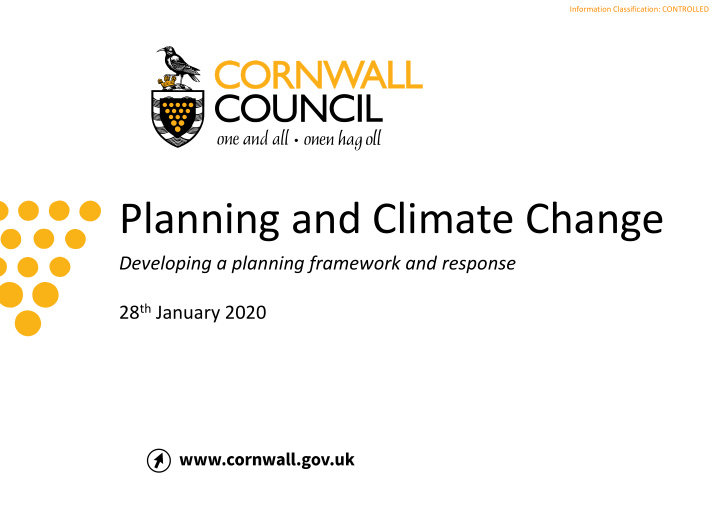



Information Classification: CONTROLLED Planning and Climate Change Developing a planning framework and response 28 th January 2020
Information Classification: CONTROLLED Early activity undertaken since July 2019 Areas we can Areas we can Areas we can Areas we can enable influence or ask Areas we directly control and guide enable through influence locally through policy for nationally funding Decision making wheel Budget challenge Behavioural change Whole House Retrofit Pilot Investment in Deep Geothermal Forest for Cornwall Climate Change Development Planning Document 50:50 Future Cornwall Local Industrial Strategy – Clean Growth Focus Cornwall Isles of Scilly Leadership Board declare Climate Emergency Localism Summit and Cornwall Schools Eco-conferences Partnering with West Midlands Combined Authority to pilot Energy Innovation Zones Lobbying Government about energy infrastructure £23.5m for secured from Department of Transport to reduce bus fares
Information Classification: CONTROLLED Programme Outcomes and Targets Outcome Target 2030 Target 2030 for 2050 Carbon Neutral Cornwall Council Pending baseline Pending baseline assessment assessment Reduce emissions from commercial, industrial 88% Reduction 39% Reduction and public sectors Cornish households reduce carbon footprint 95% reduction 30% reduction Reduce transport emissions 80% reduction 53% reduction Reduce emissions from agriculture and land use 29% reduction 14% reduction Expand renewable energy 2.5x increase to 3.5 5x increase to Gwh 5.2Gwh Increase carbon sequestration 9x to 1.39 MtCO2e 3.7x to 0.46 MtCO2e Climate Resilient communities and N/A N/A infrastructure
Information Classification: CONTROLLED Cornwall’s current carbon footprint Based on Cornwall’s current Green House Gas inventory (2016 data year) Cornwall’s current carbon footprint is 4.05 million tonnes Co2e (c28% were non-Co2 GHGs) Since the last Greenhouse Gas inventory produced in 2011 (2008 data year) Cornwall’s Co2e footprint* has reduced by c16% and at the latest estimate 37% of our electricity now comes from renewables. *Based on preliminary figures . Final 2008-2017 figures expected by September 2019
Information Classification: CONTROLLED What is proposed? • Statutory planning document • Covers planning related issues and the allocations required Limitations • Not a new local plan – helping to enhance the existing • Sits within our existing spatial strategy • Must be related to land use planning • Prepared according to the regulations and subject to examination • Only part of the answer – sits within wider climate change response
Information Classification: CONTROLLED How the document is being produced • In accordance with Regulations Soft scoping and • Examined by Independent Inspector preparation • Extensive scoping stage • Extensive early discussions with a range of people and statutory bodies to ease passage of document Formal scoping (R.18) • Early exploration of options • better opportunities for informed debate in April and August 2020 Pre-submission document Submission document
Information Classification: CONTROLLED Likely content and scope Fuller scoping stage to cover a wider range of options Can cover policy, supportive content and allocations Likely to include: Large scale renewables Energy efficiency measures Coastal change and flooding areas Natural Climate Solutions Other carbon reduction opportunities No closed doors at this time
Information Classification: CONTROLLED Renewables and energy • In order to meet the Council’s ambitions to be carbon neutral, we need to plan for a significant increase in renewable generation • The NPPF requires us to identify ‘sites suitable for wind’ • Maximise opportunities for repowering • Need additional certainty and to engage communities positively • Ensure that when we identify sites that Cornwall and its community benefit • Support emerging technologies
Information Classification: CONTROLLED Future Homes Standard Would be mandated by Government in two stages: Building Regulation Changes 2020 Future Homes Standard 2025 Currently open for consultation Proposed changes to building Regs Up to 30% improvement over existing Regs Removes ability to set own efficiency standards More consultation expected over new homes standard
Information Classification: CONTROLLED Coastal Change and flooding • Coastal communities already face threats from flooding and coastal erosion – this will increase in the future • Need to plan for communities that are vulnerable to Coastal Change and flooding • Need to prevent inappropriate development in these areas but at the same time ensure that they do not stagnate due to lack of development and remain sustainable places to live and work • Identify positive action in terms of providing for migration of uses and continued sustianability
Information Classification: CONTROLLED Biodiversity and sequestration • Biodiversity is suffering – needs protection and a net gain • We will need a large increase in sequestration by 2030 (9x to 1.39 MtCO2e) to help absorb carbon • Need to embed Nature recovery Networks and encourage network thinking • Woodland, species rich grassland and wetland opportunities mapped – what do we need to do next to protect and provide? • Need to protect trees and hedges in development and increase tree and hedge cover
Information Classification: CONTROLLED Other carbon reduction opportunities • 47% carbon from industry, road transport and agriculture • Supportive policy for service and facility provision to make communities more sustainable • Could we provide additional support for development of zero carbon, carbon innovation and off-grid communities/buildings? • Can farm diversification support carbon neutral energy such as anaerobic digestion, biofuel creation/capture etc? • Using design to reduce the need to travel and make it easier to use sustainable modes
Information Classification: CONTROLLED How are we involving people and interests? • Conversations with key agencies • Engagement of internal stakeholders • OSC and informal sessions • Regular engagement with climate change team • Research and opinion forming • Sounding board of interested people • Neighbourhood Plan Groups/Parishes • Engagement and communications approach flexible
Information Classification: CONTROLLED Neighbourhood Planning and Climate Change Minimise the contribution to Climate Change • Location of development • Protect local services • Allocate sites for renewable energy • Encourage good quality design Adaptation and Mitigation • Protect and enhance green infrastructure • Safeguard areas for flood storage • Encourage SUDs • Promote biodiversity net gain • Encourage design standards
Information Classification: CONTROLLED Guide Notes
Information Classification: CONTROLLED Meur Ras / Thank you Any questions or comments?
Recommend
More recommend